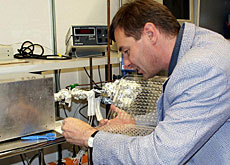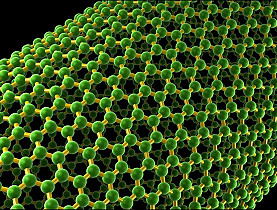Health concerns raised over nanoparticles

Titanium dioxide (TiO2) nanoparticles, widely used in sun creams and cosmetics, provoke similar inflammatory effects on the lungs as asbestos, new research has found.
A Swiss-French team of scientists warns of future health hazards caused by nanoparticles. But some doubts have been cast on the findings. The Swiss authorities are set to publish a strategy report on nanomaterials later this year.
Around two million tonnes of TiO2 nanoparticles are produced every year worldwide. They are used as a white pigment in many everyday products like paint, cosmetics, sun cream, vitamins, food colouring and toothpaste, according to an article published by the Swiss news agency.
The researchers from Lausanne University, Orléans University and the French National Centre for Scientific Research in France investigated the inflammatory capacity of TiO2 nanoparticles by testing them on human cells and in lab experiments using mice.
They found that TiO2 nanoparticles cause similar effects to asbestos and silicone, activating the inflammasome NLRP3 – a complex mechanism responsible for activating inflammation processes – and releasing molecules capable of attacking DNA, proteins and cell membranes.
“With titanium dioxide you accumulate, like asbestos, particles in the lung. You get chronic inflammation and this can last ten or 15 years and the next step is cancer,” Jürg Tschopp, the lead researcher and professor of biochemistry at Lausanne University, told swissinfo.ch.
Tschopp, who was awarded the 2008 Louis-Jeantet Prize for Medicine for his pioneering work in the fields of cell death and inflammation, said he was concerned that nanoparticles could become “the asbestos of the future”.
“Forty years ago we were at the same point with asbestos. There were some indications it was dangerous and could cause cancer, but the data and information was not solid,” he noted. “We cannot exclude at the moment that nanoparticles are as dangerous as asbestos.”
The biochemist admitted his findings, published in the PNAS journal, were not stopping him from using sun cream or toothpaste, but nanoparticles and their regulation was a long-term political issue and more caution was needed, he said.
“To avoid the same catastrophe as we had [with asbestos], we should think about where it’s not necessary to use them,” he commented.
Not always nano
The Swiss accident insurer Suva said it was following the issue closely.
“Nanoparticles should not become the asbestos of tomorrow,” it said in a statement on Tuesday.
Even now 100 people die every year in Switzerland as a result of previous exposure to asbestos, which was banned in 1990, it declared.
Huma Khamis of the consumer association of western Switzerland welcomed the new research.
“It’s important to stress that this study was done on the toxicity of titanium dioxide nanoparticles and these are not always used in consumer products in nano form,” she said.
“One exception is sun cream, so this represents a potential risk. But there is a dilemma with sun cream, as the immediate risks of not using cream and sunbathing are greater than those of exposure to products containing titanium dioxide nanoparticles. It’s a big problem.”
Tiny pioneer
According to the 2010 Swiss Nanotech report, Switzerland has been a pioneer in the science of the small, having discovered its potential early.
In 2008 the federal authorities issued a plan of action on synthetic nanomaterials and a much-awaited follow-up report is due in November on future strategies and regulations.
In December 2010 the Swiss National Science Foundation launched an extensive three-year national research programme with 18 projects looking at “Opportunities and risks of nanomaterials”.
Peter Gehr, president of the steering committee for the new national research programme, was highly critical of the new findings, however.
“It’s simply not possible to compare nanotechnology with asbestos – this is nonsense,” the lung expert and professor of anatomy told swissinfo.ch. “Concluding that from an acute cell reaction that it can lead to cancer is just crazy.”
But he admitted that there was a “big gap” in our knowledge about chronic exposure to nanoparticles and the long-term effects on humans and the environment.
There are many unanswered questions, added Khamis.
“How do titanium dioxide nanoparticles behave in products – do they stay the same or form larger molecules? What is the consumer’s exposure to them?” she said. “And the consumer has no way of knowing whether they are using a product containing nanoparticles or not.”
“Ideally the report in November will lead to a study by product or category of products that contain nanoparticles – an inventory on the levels and sources of exposure. And if need be products should be withdrawn from the market,” said the consumer test specialist.
Nanotech can be defined as research and technology developments at the atomic or molecular level, on a scale smaller than 100 nanometres – one ten thousandth of a millimetre.
Particles and structures of this size differ from their counterparts in the microscopic world as relative surface area of these structures increases enormously and quantum effects occur. This can lead to changes in physical and chemical properties, often leading to improved characteristics e.g. water repellency.
Nanoscience and nanotechnology encompass a range of techniques rather than a single discipline and stretch across the scientific spectrum, touching on medicine, physics, engineering and chemistry.
While nanotechnology offers a glimpse of a whole array of new possibilities, there are also potential risks to consider.
In 2008 the federal government approved a plan of action on synthetic nanomaterials and a much-awaited follow-on report is due in November 2011. The overall aim is to set up a regulatory framework for nanotechnology.

In compliance with the JTI standards
More: SWI swissinfo.ch certified by the Journalism Trust Initiative




You can find an overview of ongoing debates with our journalists here. Please join us!
If you want to start a conversation about a topic raised in this article or want to report factual errors, email us at english@swissinfo.ch.